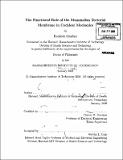| dc.contributor.advisor | Dennis M. Freeman. | en_US |
| dc.contributor.author | Ghaffari, Roozbeh, 1979- | en_US |
| dc.contributor.other | Harvard University--MIT Division of Health Sciences and Technology. | en_US |
| dc.date.accessioned | 2008-12-11T18:43:47Z | |
| dc.date.available | 2008-12-11T18:43:47Z | |
| dc.date.copyright | 2008 | en_US |
| dc.date.issued | 2008 | en_US |
| dc.identifier.uri | http://hdl.handle.net/1721.1/43876 | |
| dc.description | Thesis (Ph. D.)--Harvard-MIT Division of Health Sciences and Technology, 2008. | en_US |
| dc.description | Includes bibliographical references (p. 101-110). | en_US |
| dc.description.abstract | Sound-evoked vibrations transmitted into the mammalian cochlea produce traveling waves that provide the mechanical tuning necessary for spectral decomposition of sound. These traveling waves of motion propagate along the basilar membrane (BM) and ultimately stimulate the mechano-sensory receptors. The tectorial membrane (TM) plays a key role in this stimulation process, but its mechanical function remains unclear. Here we show that the TM supports traveling waves that are an intrinsic feature of its visco-elastic structure. Radial forces applied at audio frequencies (1-20 kHz) to isolated TM segments generate longitudinally propagating waves on the TM with velocities similar to those of the BM traveling wave near its best frequency (BF) place. We compute the dynamic shear storage modulus and shear viscosity of the TM from the propagation velocity of the waves and show that segments of the TM from the basal turn are stiffer than apical segments are. Analysis of loading effects of hair bundle stiffness, the limbal attachment of the TM, and viscous damping in the subtectorial space suggests that TM traveling waves can occur in vivo. To test how TM waves may participate in cochlear function, we investigated waves in genetically modified mice lacking beta-tectorin, a glycoprotein found exclusively in the TM. Tectb-/- mutant mice were previously shown to exhibit significant loss of cochlear sensitivity at low frequencies and sharpened frequency tuning compared to wild types. We show that the spatial extent and propagation velocity of TM traveling waves are significantly reduced in Tectb-/- mice compared to wild types, consistent with the concept that there is a reduction in the spread of excitation via TM waves and less TM wave interaction with the BM traveling wave in Tectb-/- mice. | en_US |
| dc.description.abstract | (cont.) The differences in TM wave properties between mutants and wild types arise from changes to the mechanical properties of the TM; mutant TMs are significantly less stiff than wild type TMs are. Our results show the presence of a traveling wave mechanism through the TM that can functionally couple a significant longitudinal extent of the cochlea and may interact with the BM wave, suggesting that TM waves are crucial for cochlear sensitivity and tuning. | en_US |
| dc.description.statementofresponsibility | by Roozbeh Ghaffari. | en_US |
| dc.format.extent | 110 p. | en_US |
| dc.language.iso | eng | en_US |
| dc.publisher | Massachusetts Institute of Technology | en_US |
| dc.rights | M.I.T. theses are protected by
copyright. They may be viewed from this source for any purpose, but
reproduction or distribution in any format is prohibited without written
permission. See provided URL for inquiries about permission. | en_US |
| dc.rights.uri | http://dspace.mit.edu/handle/1721.1/7582 | en_US |
| dc.subject | Harvard University--MIT Division of Health Sciences and Technology. | en_US |
| dc.title | The functional role of the mammalian tectorial membrane in the cochlear mechanics | en_US |
| dc.type | Thesis | en_US |
| dc.description.degree | Ph.D. | en_US |
| dc.contributor.department | Harvard University--MIT Division of Health Sciences and Technology | |
| dc.identifier.oclc | 263431194 | en_US |
